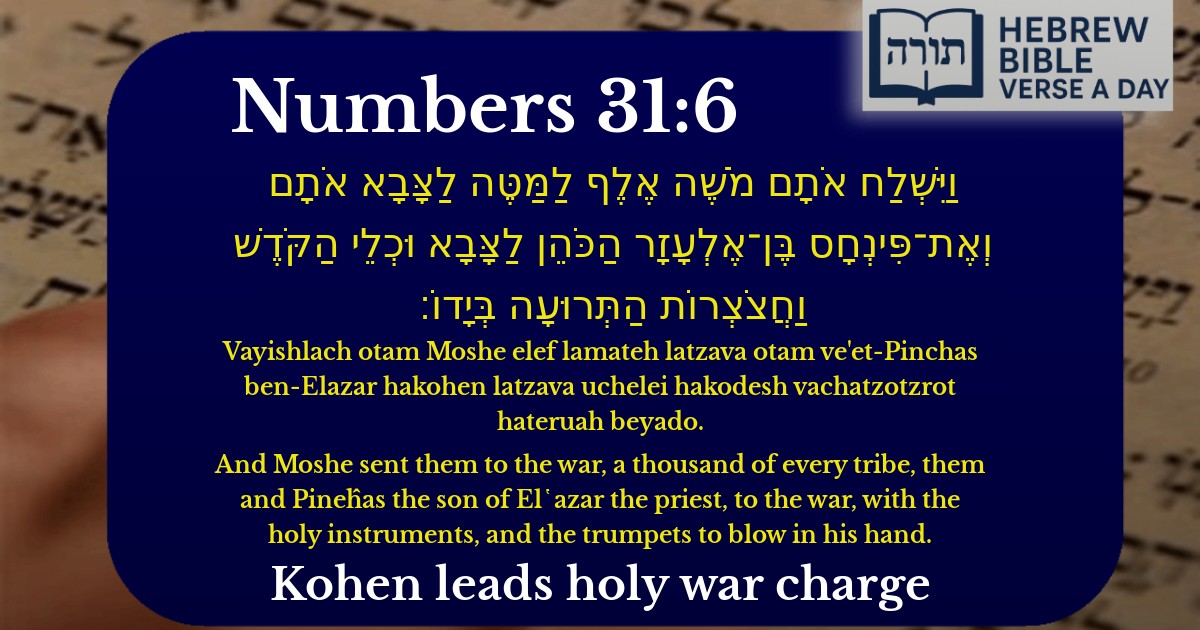Frequently Asked Questions
Q: Why did Moshe send Pinchas to war with the soldiers?
A: According to Rashi, Pinchas was sent because he had previously shown great zeal for Hashem during the incident with Zimri (Numbers 25:7-8). His presence would inspire the soldiers and remind them they were fighting a holy war (milchemet mitzvah). The Midrash adds that Pinchas brought the Ark and the Divine Name as spiritual protection for the army.
Q: What were the 'holy instruments' mentioned in this verse?
A: The Talmud (Sotah 43a) explains these were either the Ark of the Covenant or the Urim v'Tumim (the High Priest's breastplate). Rambam (Hilchot Melachim 7:1) states these holy items were brought to inspire the soldiers and remind them that Hashem was with them in battle.
Q: Why were trumpets blown during war?
A: The trumpets (chatzotzrot) served multiple purposes: 1) As a call to assemble the troops (Rashi), 2) To inspire fear in the enemy (Midrash Tanchuma), and 3) Most importantly - to remind the soldiers to direct their hearts to Hashem, as the verse states 'When you go to war... you shall be remembered before Hashem' (Numbers 10:9).
Q: Why were exactly 1,000 men sent from each tribe?
A: The number 1,000 represents completeness in military units (Ramban). Additionally, the Talmud (Sanhedrin 16a) explains this teaches that even when going to war, the majority of the nation remained home to continue regular Torah study and mitzvah observance - showing that spiritual pursuits are never abandoned, even during military campaigns.
Q: How does this verse apply to Jews today?
A: The principles remain relevant: 1) When facing challenges (personal or national), we should approach them with spiritual preparation (like the holy instruments), 2) We need righteous leaders (like Pinchas) to guide us, and 3) We must remember to call out to Hashem in difficult times (symbolized by the trumpets). The verse teaches that physical efforts must be accompanied by spiritual awareness.


Context of the Verse
This verse (Bamidbar 31:6) describes Moshe's preparation for the battle against Midian, where he sends 1,000 soldiers from each tribe, accompanied by Pinchas the Kohen and sacred vessels. The inclusion of Pinchas and the holy instruments highlights the spiritual dimension of this military campaign.
Role of Pinchas
Rashi (Bamidbar 31:6) explains that Pinchas was sent because he had previously demonstrated his zeal for Hashem during the incident with Zimri (Bamidbar 25:7-8). The Midrash (Bamidbar Rabbah 22:4) adds that Pinchas went as a representative of the divine presence, ensuring the soldiers' success through his merit.
The Holy Instruments
The "holy instruments" (כְּלֵי הַקֹּדֶשׁ) mentioned here are interpreted by Ramban (Bamidbar 31:6) as the Ark of the Covenant, which accompanied the troops to inspire them and remind them of their divine mission. The Talmud (Sotah 43a) states that the Ark contained the broken tablets as well, symbolizing that even in times of brokenness, Hashem's presence remains with Israel.
The Trumpets
The "trumpets of teruah" (חֲצֹצְרוֹת הַתְּרוּעָה) served multiple purposes, as explained by the Rambam (Hilchot Ta'aniyot 1:1-4):
Spiritual Dimension of Warfare
The Malbim (Bamidbar 31:6) emphasizes that this military campaign was not merely physical warfare, but a sacred mission to carry out divine justice. The presence of Pinchas and the holy vessels transformed the battlefield into a space of kedushah (holiness), ensuring that the soldiers maintained proper intentions and awareness of their higher purpose.